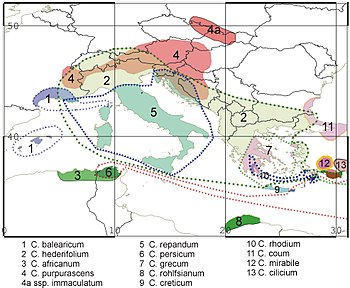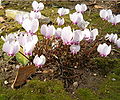Ivy-leaved cyclamen
| Ivy-leaved cyclamen | ||||||||||||
|---|---|---|---|---|---|---|---|---|---|---|---|---|

Ivy-leaved cyclamen ( Cyclamen hederifolium ) |
||||||||||||
| Systematics | ||||||||||||
|
||||||||||||
| Scientific name | ||||||||||||
| Cyclamen hederifolium | ||||||||||||
| Aiton |
Cyclamen hederifolium is a species of the genus cyclamen ( Cylamen ) within the primrose family (Primulaceae). As trivial names Efeublättriges cyclamen, autumn cyclamen, Cyclamen Neapolitan, Neapolitan be used flat earth. It is common in the northern Mediterranean.
description
Vegetative characteristics
Cyclamen hederifolium grows as a perennial herbaceous plant and reaches heights of 10 to 15 cm. As a persistence organ, it forms a tuber that is only rooted on the upper side. The tubers grow steadily, reach a diameter of 15 to 20 cm and are more durable than, for example, those of cyclamen coum .
The leaves only develop after the flowers appear in August or September. The leaves overwinter and form a basal rosette of leaves by late spring and a green sheet of leaves when they appear in small groups. The leaf shape of the cyclamen hederifolium is partly similar to that of the ivy. The leaves are divided into a petiole and a leaf blade. The shape of the spade is quite variable and ranges from ivy-like jagged to heart-shaped or spear-shaped. The upper side of the leaf is dark green with a more or less pronounced silvery pattern. The underside of the leaf is greenish.
The white flowering form Cyclamen hederifolium f. album occurs in the wild and is said to be stronger than the rose-blooming forms.
Generative characteristics
The flowering time is in the second half of the year from August to October. The flowers stand individually on a 10 to 15 cm long inflorescence stem. The hermaphrodite flowers are five-fold with a double flower envelope . The petals are dark to light pink in color and have a dark spot at the base. The flowers smell weak and are characterized by the turned back petals, which form a pentagonal throat.
Immediately after flowering, the inflorescence shafts roll up from above. The spherical capsule fruits ripen lying on the ground and surrounded by the flower stalks until the following early summer. The seeds germinate in autumn. In the first year, seedlings produce a single leaflet that lasts through the winter and is about 5 mm wide.
Occurrence
The wide distribution area of Cyclamen hederifolium extends in the Mediterranean area from southern France to western Turkey and it occurs on the Mediterranean islands of Corsica , Sardinia , Crete and the Aegean Sea . Cyclamen hederifolium thrives there in forests and scrubland in rocky areas at altitudes of up to 1300 meters, mostly over limestone .
use
Despite its southern origin, cyclamen hederifolium is hardy even in Central Europe and is one of the easiest to cultivate cyclamen species. It thrives in partial shade on well drained soil, in the garden but also on most garden soils ; there it also tolerates sunny locations. It spreads easily through seeds and feral in suitable locations.
swell
literature
- J. Krejca, A. Jakobova: Rock garden plants. VEB Deutscher Landwirtschaftsverlag, Berlin 1989, ISBN 3-331-00185-6 , p. 178.
- Fritz Köhlein: The big book of rock garden plants. Ulmer, Stuttgart 1994, ISBN 3-8001-6559-7 .
- Christopher Gray-Wilson: Cyclamen: A Guide for Gardeners, Horticulturists and Botanists . Pavilion Books, 2015, ISBN 978-1-84994-221-8 ( limited preview in Google Book Search).
Individual evidence
- ↑ Christian Grunert: The great bulb book. Berlin: VEB Deutscher Landwirtschaftsverlag, 1990, ISBN 3 331-00193-7 .
- ^ Oleg Polunin, Anthony Huxley: Flowers on the Mediterranean. BLV Munich Basel, Munich 1970.
- ↑ Fritz Köhlein, The great book of rock garden plants. Ulmer, Stuttgart 1994, ISBN 3-8001-6559-7 .






